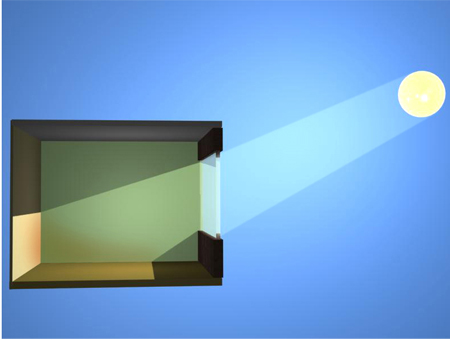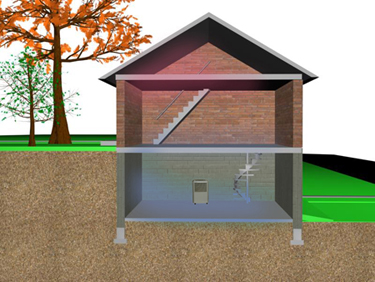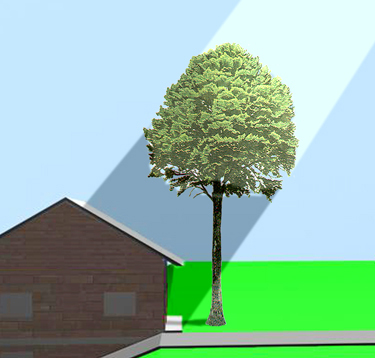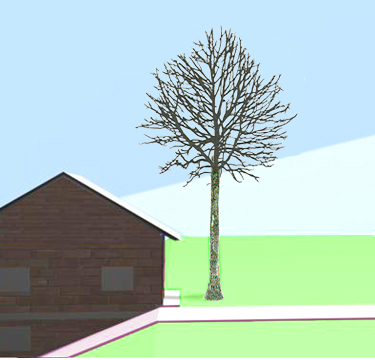Passive solar is the harnessing of the sun's energy - light and heat - without the use of any mechanical devices. It is a system that was previously used by the ancient Egyptians and Incas, but has been conveniently forgotten. For the last 100 years, we have been relying on mechanical equipment to keep us warm and cool, and we have neglected to use the sun as our focus and tool. (Some older homes you can still see a trace of passive solar principles). It is important to re-invent and activate this system to reduce our energy use.
There are 2 main categories of Passive Solar:
Direct Gain: The living area itself acts as a collector of solar energy.
Indirect Gain: A mass wall, made from a dense masonry (Trombe wall) is located 3-6 inches away and on the inside of the window, made with high-performance glass, on the south side of the house. That mass wall acts a collector of solar energy.
 Direct
Gain: Direct gain can be the most cost effective of all passive designs
because the heat produced by sunlight hitting the walls, floors and other objects
does not have to be transferred to another part of the house. The sun heats
up the floor and wall(s) during the day and radiates the heat back into the
room during the night. The time lag and duration of the transfer depends on
the thickness, material, and insulation of the floor.
Direct
Gain: Direct gain can be the most cost effective of all passive designs
because the heat produced by sunlight hitting the walls, floors and other objects
does not have to be transferred to another part of the house. The sun heats
up the floor and wall(s) during the day and radiates the heat back into the
room during the night. The time lag and duration of the transfer depends on
the thickness, material, and insulation of the floor. -Passive solar designs concentrate glazing on the south side of the house combined with thermal mass to store heat and prevent overheating. Have at least five square feet off our-inch-thick mass for every square foot of glass and you will have enough capacity for storing the sun's heat for use later at night. South-facing glass ranges from 7% to 12% of the total floor space. A solar home will overheat if the proper ratio of glass to floor & wall mass ratio is not properly balanced. If approximately 7% of the floor & wall mass area is used as glass area the wall & floor mass will absorb the heat gain. When glazing exceeds the 7%, additional mass is required or the house will overheat on sunny days. It's important to follow that glass-to-mass ratio.
-In most climates, north- and east-facing glass should be minimized to no more than 4% of the floor space. West-facing glass should not exceed 2% of the total floor space.
-Do not cover the thermal storage area with carpet and select and arrange furniture so the sun can heat the floor, not the carpet or furniture.
-Use double-pane windows and/or shutters to reduce night-time heat loss.
-Un-insulated glass wall lose heat at night and will make one side of the house cooler than the rest. Cover the windows at night with insulating blinds or drapes. Exterior or interior insulated shutters or quilted roman shades work also..
 Indirect
Gain: The sun heats up the mass wall during the day and radiates the heat
back into the room during the night. The time lag and duration of the transfer
depends on the thickness of the mass. During the day, cool air is drawn through
floor-level vents. The air between the glass and the wall heats up and enters
the room through vents at the top where the cycle repeats itself as long as
sunlight strikes the wall. After sunset, the vents need to be closed in order
to prevent heat-loss. To have a view to the outside world, small windows can
be made in the mass wall.
Indirect
Gain: The sun heats up the mass wall during the day and radiates the heat
back into the room during the night. The time lag and duration of the transfer
depends on the thickness of the mass. During the day, cool air is drawn through
floor-level vents. The air between the glass and the wall heats up and enters
the room through vents at the top where the cycle repeats itself as long as
sunlight strikes the wall. After sunset, the vents need to be closed in order
to prevent heat-loss. To have a view to the outside world, small windows can
be made in the mass wall. -Indirect gain is good for the mildest to the most severe climates.
-Windows can be installed in storage walls for daylighting or (buildingcode) egress in bedrooms.
More Passive Systems: Thermal Envelop (energy efficient but a fire hazard and very expensive), Earth Shelter, Attached Sunspace (south wall should be totally glazed and tilted 55-60°. Vertical still gets 85% of solar heat.), Day Heaters, Sun Space, Isolated Gain, Roof Pond.
Passive solar Principles (Summary):
Orientation and Layout:
-After having choosen a location with good solar exposure, orient the house, with deviation of not more than 10°, to the south, with the long axis facing south, concentrating glass on the south wall, insulating well, and providing overhangs, shade, and thermal mass. At a 30° deviation, the percentage of solar heat will drop by about 10 percent from that of true south. Over 30° of deviation will result in a sharp drop in the available solar heat. Plan the room layout accordingly. Plan openings and room layouts that aid movement of solar heated air from passive solar rooms to other actively-used rooms in the home.
Windows:
-Increase South-facing glass area (7-12% of the floor area) or adding windows can be one of the most cost effective ways to add solar heat to your home. sunlight can enter the house directly to add to your warmth and comfort. For more info click on windows , or in the main menue.
-North- and East-facing glass should be minimized, each accounting for no more than 4% of the floor space.
-Lower East and West glass areas prevents unwanted sun in morning and afternoon. West facing glass should not exceed 2% of the total floor space. Windows facing west pick up virtually no direct sunlight in winter, but can cause severe overheating problems in the summer when the afternoon sun lingers in the western sky.
-South windows let sunlight into the building in winter and can be shaded effectively in summer.
-Use effective window shading. Overhangs, shutters, blinds, shade screens, curtains, and landscaping shade unwanted sunlight in summer.
Thermal Storage Mass (concrete, brick, tile; insulate the vertical edge of the slab. Slabs used as thermal mass should also be insulated underneath ) Tile-covered slab floors, masonry walls, and water-filled containers save energy all year.
Use Natural Cooling Design Components

-Ventilation: Natural breezes through windows on opposite sides of the house, ceiling fans, whole house fans, and space fans keep the house more comfortable during non-heating and cooling periods of the year.
-Earth-shelter: Imbed the building to use the cool ground (thermal mass). The deeper into the earth a house is built, the more stable the temperature. The ideal location for an underground home is on a south-facing-slope. The north, east and west walls can be set into the hillside while the south wall is left exposed for the passive solar heating. Most underground houses are constructed of 8-inch to 12 inch reinforced concrete walls, which serve as excellent storage for solar radiation collected through south-facing glass.
 -
- Place
trees "efficiently" so
they shade the home in the summer, but let the sun through in the winter.
Place
trees "efficiently" so
they shade the home in the summer, but let the sun through in the winter. © 2008 Michiel VanderSommen